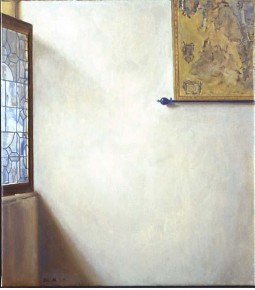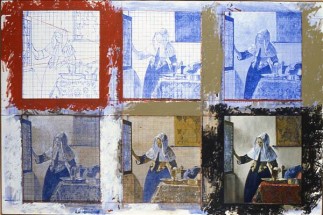| WorkWoman with a Water Pitcher
| Image Notes
Click highlighted words for image and information
Reference Vermeer, Young Woman with a Water Pitcher, c. 1664-65. The Metropolitan Museum of Art, New York. Vermeer's rooms are turned into spaces of breathtaking suspense in George Deem's fictions of what they are in addition to their being the settings for domestic scenes. This is the art of adding by subtraction. Take a Vermeer, subtract figures, furniture, props, and much more emerges. Subtract the temptation to allegorize and you get newly focused vision.... Deem's interiors are explorations of how to paint beyond the realism that makes things invisible through routine perception. (Mieke Bal, Gallery invitation/announcement "George Deem: Vermeer Extended: New Paintings," Pavel Zoubok Gallery, New York, March 21-April 20, 2002. (George Deem) paints versions of Vermeer, but not in the usual, and by now superficial, postmodern sense of "quoting" or "appropriating" the Dutch master. Rather, he skillfully executes a Vermeer, but without the people present in those lush, redolent interiors, as in "An Allegory of Faith" (2002), or he shows us what would be read as a "detail" of a Vermeer masterpiece, as in "Woman with a Water Pitcher" (2002), as if resting comfortably on the page of an art history textbook. In a sense he is creating what I would call a temporal collage. Rather than attacking the picture plane and its flatness, as Picasso and Braque were said to have done in their papier collies of 1912, Deem creates a temporal rearrangement. Where the founders of cubism used commercially manufactured wallpaper in newly spatialized combinations with other graphic material to open up the semantic code of the represented image, Deem uses our memory of the "true" Vermeer as a present absence to qualify what we are seeing. But as with the well known use of modernist collage, the irony cuts both ways. We "see" a Vermeer that is not there, and we see a Vermeer-like effect that is altogether there. Deem's great technical skill -- which he himself mocks or self-criticizes by painting in test patches or uneven, roughly executed borders -- allows for something like a negative dialectic. If Deem can in fact paint like Vermeer, and the memory activated by such skill is fully estheticized, then why should we accept the usual sense of "Time's arrow," the belief that art history, like the larger history on which it is often parasitical, must be ineluctably one dimensional and future oriented. In some paintings what is being collaged is not space, or some sense of spatial forms, but rather time. Of course, all collage is in some sense both spatial and temporal, though it is clear that some instances operate rather more dominantly in one or the other dimension. In what we can call "temporal collage' (as opposed to the spatial variety), we see two differently temporalized images. The historical context of one image, or its partial representation, is being juxtaposed against another historical moment, or against the "now" of the painting. (Charles Molesworth, "How To Live in an Image World: The Strategies of Memory," Salmagundi, Summer-Fall 2003). George Deem's "Woman with Water Pitcher," 2002, substitutes a simple corner of the Vermeer masterpiece for the whole, suggesting that every detail of the original artwork contains its essential character and the fragmentary nature of the modern work of art. ("Art on Art," Adam Baumgaold Gallery, New York, May 17 - June 25, 2011). Scroll down to "Previous Exhibitions" at http://www.adambaumgoldgallery.com Deem's own Vermeer epiphany...was in keeping with a nearly century-old American fascination. But whatever Vermeer's impact had been on earlier American artists, Deem would deal with the specific elements of Vermeer's paintings in a more intimate and intense manner than they had, not merely by taking inspiration from Vermeer's style, but by dissecting every element of his art, analyzing it, and reconstructing it, often within new contexts. In fact, Deem's methodology often involved subtraction, thereby taking Vermeer's approach to another level. If Vermeer's figures are physically quiet, temporarily withdrawn from active society, Deem's might be literally withdrawn from the composition. A case-in-point is the series he created by manipulating Vermeer's famous Young Woman with a Water Pitcher ca. 1664-65. For example, in How to Paint a Vermeer of 1981, Deem demonstrated how artists copy images using simple grid systems. Having thus constructed Vermeer'sYoung Woman with a Water Pitcher from scratch, as it were, Deem deconstructed it. In his Young Woman with a Water Pitcher, Again, 2005, Deem moved Vermeer's protagonist out of the picture proper and into a painting-within-the-painting (thus the title of the work). In Deem's Woman with a Water Pitcher, 2002, she disappears altogether. (David Dearinger, "George Deem," exhibition catalogue essay,George Deem: The Art of Art History, The Boston Athenaeum, April 11 - September 1, 2012, p. 21-22). | ExhibitionsPavel Zoubok Gallery, New York
Yale University Jonathan Edwards College Master's House
Adam Baumgold Gallery, New York
The Boston Athenaeum, Boston, Massachusetts
|
| WorkWoman with a Water Pitcher
| Image Notes| Exhibitions |




